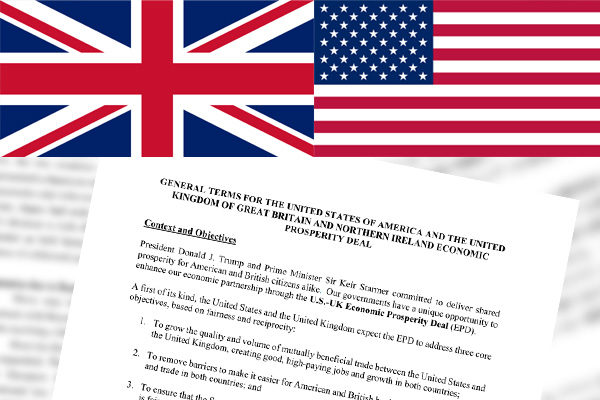The United States and Britain have reached agreement at their tariff negotiations. While maintaining the basic 10% reciprocal tariff imposed by the U.S. Trump administration, the agreement slashed the U.S. additional 25% tariff on British steel and aluminum products and automobiles. An import quota was established to reduce the tariff on passenger cars to 10% and the levy on steel and aluminum products was made zero.
Asked about the U.S.-Britain agreement, Prime Minister Shigeru Ishiba and other Japanese officials say they would seek to eliminate all high tariffs imposed by the Trump administration. But Washington emphasizes the tariff mitigation for Britain is an exception. The path to the high tariff exemption that Japan desires would be bumpy.
Seasoned British diplomatic approach
This is not to say that the U.S.-Britain agreement has no implication for Japan. Pay attention to a reference to British efforts to block Chinese steel dumping. Britain had retained a pro-China stance on the economic front, making the London financial market the world’s largest outside China and Hong Kong for yuan settlements. In April, however, Britain placed British Steel, which was under the umbrella of a Chinese company, under direct government control. Washington praised the move as a way to prevent cheap Chinese steel products from being exported to the U.S. via Britain. London, known for its seasoned diplomatic approach, quickly moved at least partially to resonate with the Trump administration’s hardline China policy, making a successful appeal to Washington.
China’s economic and military threats to Japan are far greater than those to Britain. By inviting companies from Japan, the U.S. and Europe to found joint ventures with Chines state-owned enterprises, China has absorbed advanced technologies and manufacturing knowhow to dramatically expand exports of many industrial products and overwhelm the U.S. manufacturing industry. It has used its trade surplus dollars to acquire interests in mineral resources around the world to win an overwhelming share of global supply for rare earths and rare metals that are indispensable for high tech products and weapons. It continues to expand its military power, utilizing its economic growth as a stepping stone.
After successive U.S. administrations left untouched China’s external expansion policy that has ignored the international order, the first Trump administration, inaugurated in 2017, finally imposed punitive tariffs on China. The second Trump administration aims to revive U.S. manufacturing through high tariffs. but as the 145% tariff on China suggested, this policy implies containment of China.
Trump tariff is a good opportunity for Japan
Japan, which faces Chinese threats on a daily basis, should see the Trump administration’s high tariff policy as a good opportunity to share China strategy with the U.S.. However, the Ishiba government sees the Trump tariff only as a national crisis for Japan and is busy with working out stopgap measures to tackle the crisis. Key cabinet ministers of the Ishiba government are hopeful of a “mutually beneficial relationship based on common strategic interests” with Beijing and may accept the Chinese call for the resumption of negotiations for a trilateral free trade agreement between Japan, China, and South Korea.
Ishiba should completely abandon his illusions about China and propose an economic strategy toward China that Japan and the U.S. could share. That would be the premise for Trump’s reversal of high tariffs on Japan. This should be the only implication of the U.S.-Britain agreement for Japan.
Hideo Tamura is a Planning Committee member at the Japan Institute for National Fundamentals and a senior correspondent for the Sankei Shimbun newspaper.


